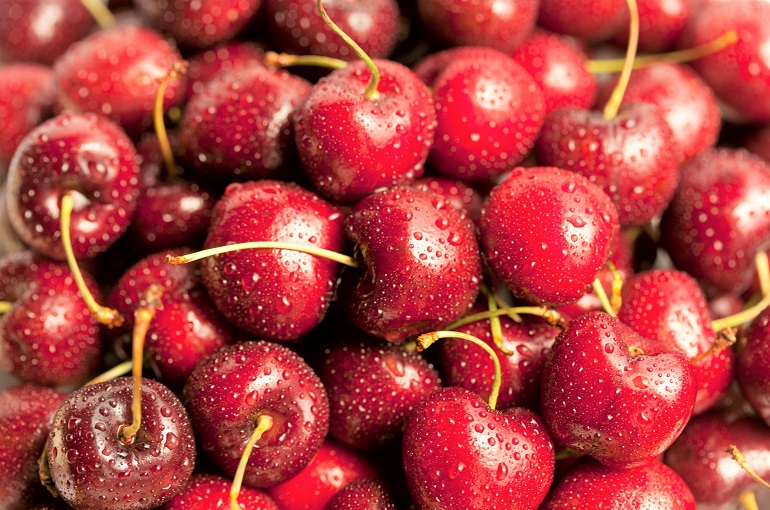Cherries: Info, Facts, Nutritional Value & Health Benefits

This post is also available in:
This post is also available in:
![]() Español (Spanish)
Español (Spanish) ![]() Français (French)
Français (French) ![]() Deutsch (German)
Deutsch (German) ![]() Nederlands (Dutch)
Nederlands (Dutch) ![]() हिन्दी (Hindi)
हिन्दी (Hindi) ![]() العربية (Arabic)
العربية (Arabic) ![]() Türkçe (Turkish)
Türkçe (Turkish) ![]() 简体中文 (Chinese (Simplified))
简体中文 (Chinese (Simplified)) ![]() Ελληνικά (Greek)
Ελληνικά (Greek) ![]() Português (Portuguese (Brazil))
Português (Portuguese (Brazil))
The cherry tree belongs to the genus Prunus spp. like other trees, such as peaches, nectarines, and almonds. It is a flowering tree that belongs to the Rosaceae family. It is a perennial, deciduous tree that can grow and produce fruits for 40-50 years or more. There are two commercially important cherry species: sweet or true cherries (Prunus avium) and sour (Prunus cerasus) cherries. While cherry trees are usually grown for their edible fruits, they also have an ornamental value due to their beautiful white-pink flowers. There are many cherry trees in Japan that are cultivated for this use. They are also known as Cherry-blossoms and Sakura trees (in Japanese).
Cherry producing countries
Thanks to the great variety of species and cultivars, cherries production has spread worldwide and become popular in many countries. Nowadays, cherry trees are mainly grown in Asia, Europe, and the USA. The top 5 cherry producing regions are the following.
- Turkey (28% of the global production)
- E.U. (Italy, Spain, Greece, France)
- USA (Michigan, Oregon, California, and Washington)
- China
- Chile
Cherry trees are widely known for their delicious fruits. People love to eat both sweet and sour cherries. Sweet cherries are usually grown for commercial use and can be easily found in fresh local markets. On the other hand, it is difficult to ship sour cherries. Sour/Tart cherries are quite small and usually don’t last long after harvesting, so most growers freeze them. People often consume sweet cherries as fresh fruits. Sour cherries are mainly used as processed in pies and sauces. Furthermore, cherries can be processed to produce juice. Both cherry types are tasty, depending, of course, on our preferences.
Nutritional Value of Cherries
Cherries are low-calorie fruits with a high concentration of water (more than 82%). Besides being delicious, fresh cherries provide us with plenty of nutrients and improve our health. According to the USDA, 100 grammars of sweet cherries contain 63 kcal, and 100 grammars of sour cherries contain just 50 kcal. Generally, one cup of fresh cherries weighs 140 g (5 oz.).
Cherries Nutrient Values:
According to the USDA, 100 g of raw cherries contain:
Sweet cherries
- 82,25 g Water
- 63 kcal Energy
- 1,06 g Protein
- 0,20 g Total Lipid (fat)
- 16,01 g Carbohydrate
- 2,1 g Fiber
- 12,82 g Sugars
- 13-16 mg Calcium
- 200-222 mg Potassium
- 20 mg Phosphorus
- 7 mg Vitamin C
- 2,1 μg Vitamin K
Sour cherries
- 86,13 g Water
- 50 kcal Energy
- 1 g Protein
- 0,30 g Total Lipid (fat)
- 12,18 g Carbohydrate
- 1,6 g Fiber
- 8,49 g Sugars
- 14 mg Calcium
- 10 mg Magnesium
- 173 mg Potassium
- 15 mg Phosphorus
- 10 mg Vitamin C
- 2,1 μg Vitamin K
Additionally, the cherries are rich in polyphenols, with 1,500 mg per kg of fresh fruit.
Cherries Health Benefits
Cherries are very tasty fruits that provide us with essential nutrients and help us remain healthy.
6 Health Benefits of Cherries
- Improve heart health. Cherries contain fiber which helps against cardiovascular diseases. Moreover, potassium (K) can help in lowering blood pressure.
- Promote skin anti-aging. Cherries contain plenty of antioxidants, which are effective against free radicals. Therefore, cherries may reduce skin aging.
- Potential anti-cancer use. Cherries are rich in antioxidants that may help against various types of cancer (especially colon cancer).
- Fight against inflammation. Cherries are rich in Vitamin C and other antioxidants, which may reduce the possibility of inflammation.
- Potential anti-diabetes action. Cherries contain anthocyanins, which are strong antioxidants and help lower the sugar levels in our blood. Thus, cherries may aid people who have diabetes.
- Weight Management. Cherries are low in calories and can be part of a healthy diet.
Cherries: Info, Facts, Nutritional Value & Health Benefits
Plant Information of cherries
10 Interesting Things About Cherries You Probably Didn’t Know
Growing Cherry Trees for Profit
Soil requirements, preparation, and planting of cherry trees
Cherry Tree Water Requirements
Cherry Tree Propagation and Pollination
Cherry Tree Training, Pruning, and Fruit Thinning
Cherry Tree Fertilization
Cherry Tree Pests and Diseases
Cherries Harvesting and Yield per Hectare – Do you pick cherries with the stem on or off?








































































